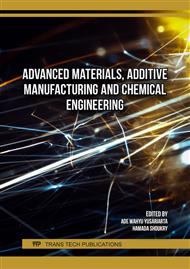[1]
L. Pieter, Van den Berg, A. Guido, G. Legemaate, D. Rob, Van der Mei, Increasing the Responsiveness of Firefighter Services by Relocating Base Stations in Amsterdam, Informs Journal on Applied Analytics, Vol. 47, No. 4 2017
DOI: 10.1287/inte.2017.0897
Google Scholar
[2]
S. Särdqvist, G. Holmstedt, Correlation Between Firefighting Operation and Fire Area. Analysis of Statistics, Fire Technology 36, 109–130 (2000)
DOI: 10.1023/A:1015450308130
Google Scholar
[3]
Vortex the Only Hybrid Nitrogen–Water Fire Suppression System (2008), http://www.firesafetyinc.com/PDFs/Vortex%20Brochure.pdf
Google Scholar
[4]
E. Degroote, P. García Ybarra Flame propagation over liquid alcohols, J Therm Anal Calorim 80, 541–548 (2005)
DOI: 10.1007/s10973-005-0735-1
Google Scholar
[5]
S. Samim, A. Sadeq, S. Ahmed, (June 14, 2016), Measurements of Laminar Flame Speeds of Gas-to-Liquid-Diesel Fuel Blends, ASME. J. Energy Resour. Technol. September 2016; 138(5): 052213
DOI: 10.1115/1.4033627
Google Scholar
[6]
Forssell, E. W., Scheffey, J. L., DiNenno, P. J., Back, G. G. (2004). False Deck Development Testing of Hybrid Nitrogen – Water Mist Fire Suppression Systems. Halon Options Technical Working Conference (HOTWC), New Mexico Engineering Research Institute (NMERI), Albuquerque, NM.
Google Scholar
[7]
Sistema avtomaticheskogo pozharotusheniya «Zashchitnyy tuman» (2012), https://www.startbase.ru/innovations/63/
Google Scholar
[8]
Mohd Aliff, Nor Samsiah Sani, MI Yusof Azavitra Zainal, Development of Fire Fighting Robot (QRob) January 2019 International Journal of Advanced Computer Science and Applications 10 (1)
DOI: 10.14569/IJACSA.2019.0100118
Google Scholar
[9]
Kai Wang, Yingfeng Yuan, Mengmeng Chen , Zhen Lou , Zheng Zhu, Ruikun Li, A Study of Fire Drone Extinguishing System in High-Rise Buildings Fire 2022, 5 (3), 75
DOI: 10.3390/fire5030075
Google Scholar
[10]
Wu, C., Zhou, T., Chen, B. et al. Experimental Study on Burning Characteristics of the Large-Scale Transformer Oil Pool Fire with Different Extinguishing Methods, Fire Technol 57, 461–481 (2021)
DOI: 10.1007/s10694-020-01012-x
Google Scholar
[11]
Taylor, G. (2001). Time is Up for Halons. Industrial Fire Journal, 41, 63–64, 67–68.
Google Scholar
[12]
H. Zhi, Y. Bao, L. Wang, Y. Mi. Extinguishing performance of alcohol-resistant firefighting foams on polar flammable liquid fires, Journal of Fire Sciences. 2020; 38(1): 53-74
DOI: 10.1177/0734904119893732
Google Scholar
[13]
Rajput, Shubham. (2018). Fire Extinguishing Agents: Sort and Comparison, International Journal for Research in Applied Science an8d Engineering Technology. 6. 557-667
DOI: 10.22214/ijraset.2018.3090
Google Scholar
[14]
Zhurbinskiy, D. A. (2014). phlegmatization of gaseous combustible media with mixtures of fire-extinguishing aerosols and gaseous fire-extinguishing substances. L., 19.
Google Scholar
[15]
D. Kroca, K. Klouda, Application of aerosol extinguishing agents to increase infrastructure safety Volume 444, Advances in Environmental Engineering 25–27 November 2019, Ostrava, Czech Republic 2020 IOP Conf. Ser.: Earth Environ. Sci. 444 012030
DOI: 10.1088/1755-1315/444/1/012030
Google Scholar
[16]
Ilichkin, V.S., Kopylov, N.P., Potanin, B. V. (2002). Eksperimentalnoye opredeleniye i otse8nka pokazateley toksicheskoy opasnosti ognetushashchikh aerozoley. Pozharnaya bezopasnost, 4, 75–79.
Google Scholar
[17]
Yongfeng, Z., Xiang, J., Guangxuan, L., Ni, X. (2007). Experimental Study of the Fire-extinguishing Effectiveness of 1-Bromo- 3,3,3-Trifluoropropene/Nitrogen Mixtures. Journal of Fire Sciences, 25 (2), 177–187
DOI: 10.1177/0734904107067914
Google Scholar
[18]
Yu Liu, Bo Li, Chuanping Wu, Baohui Chen, Bichen Pan, State Key, Effectiveness Test and Evaluation of Transformer Fire Extinguishing System, Fire Technology. 2022, 58, 3167–3190. 120.1007/s10694-022-01297-0
DOI: 10.1007/s10694-022-01297-0
Google Scholar
[19]
Sébastien Muller, Ryan Brady, Gaël De Bressy, Philippe Magnier, Prevention of Transformer Tank Explosion: Part 1 — Experimental Tests on Large Transformers, ASME 2008 Pressure Vessels and Piping Conference
DOI: 10.1115/PVP2008-61526
Google Scholar
[20]
Li et al., Experimental Study on Effects of Nozzle Explosion Damage on Performance of Water Spray Fire Protection System of Ultra-high Voltage Transformer, 6th Asia Conference on Power and Electrical Engineering (ACPEE), Chongqing, China, 2021, pp.1200-1206
DOI: 10.1109/ACPEE51499.2021.9437001
Google Scholar
[21]
R. Meenakshi, S. Amit, K. Yogesh, S. Inderpal, T. Kumar., N. Rajiv, Condensed Aerosol Based Fire Extinguishing System Covering Versatile Applications: A Review, Fire Technology. 2022. Vol. 58, P. 327–351
DOI: 10.1007/s10694-021-01148-4
Google Scholar
[22]
Zhang, Xiaotian; Ismail, Mohd Halim Shah; Ahmadun, Fakhrul-Razi b. Abdullah, Norhafizah bt. Hj.; Hee, Choi, Hot aerosol fire extinguishing agents and the associated technologies: a review, Brazilian Journal of Chemical Engineering 32 (3) Sept 2015
DOI: 10.1590/0104-6632.20150323s00003510
Google Scholar
[23]
Y. Yan, Z. Du, Z. Han, A novel hot aerosol extinguishing agent with high efficiency for Class B fires. Fire and Materials. 2019; 43: 84-91
DOI: 10.1002/fam.2671
Google Scholar
[24]
D. Kroca, K. Klouda, Application of aerosol extinguishing agents to increase infrastructure safety IOP Conference Series Earth and Environmental Science, 444(1), 012030 - January 2020
DOI: 10.1088/1755-1315/444/1/012030
Google Scholar
[25]
Korostelev, V.G.(2002). Aerozolgeneriruyushchiye pozharotushashchiye sostavy. Osnovnyye tipy sostavov i optimalne usloviya ikh primeneniya. Pozharovzryvobezopasnost, 1, 61–66.
Google Scholar
[26]
V. Balanyuk, V. Myroshkin, O. Harasimiuk, Y. Kopystinsky. Screening Ability of Environmentally Friendly Aerosols for Thermal Radiation. KEM 2023; 954:195–200
DOI: 10.4028/p-PQs6tx
Google Scholar


